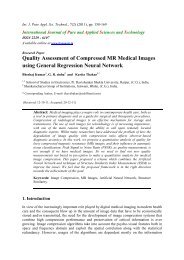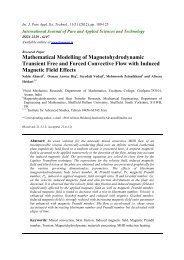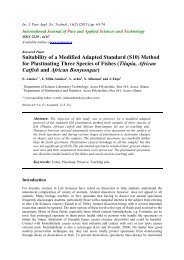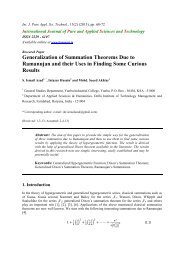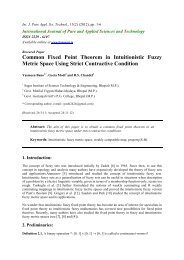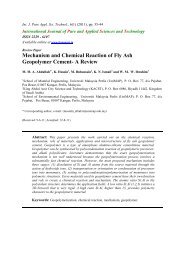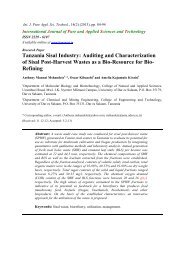Biosorption of Heavy Metals from Aqueous Solution using Bacillus Licheniformis
Biosorption of Heavy Metals from Aqueous Solution using Bacillus ...
Biosorption of Heavy Metals from Aqueous Solution using Bacillus ...
- No tags were found...
Create successful ePaper yourself
Turn your PDF publications into a flip-book with our unique Google optimized e-Paper software.
Int. J. Pure Appl. Sci. Technol., 10(2) (2012), 12-19. 15<br />
Effect <strong>of</strong> pH:<br />
The pH <strong>of</strong> the solution is the most critical parameter for metal sorption as it influences both the<br />
bacterial surface chemistry as well as solution chemistry <strong>of</strong> soluble metal ion. Different metals show<br />
different pH optima for their biosorption (Donmez et al. 1999; Saeed and Iqbal 2003).<br />
Fig.1 shows % removal <strong>of</strong> heavy metal ions at pH- 2.5, 3, 3.5, 4, 4.5. It was found to be in the range<br />
<strong>of</strong> 14 – 95 %. Maximum biosorption was observed at pH 3.5 for iron and chromium ion with removal<br />
efficiency <strong>of</strong> 95% and 52% respectively. pH 2.5 was found to be optimum for Cu ion giving the<br />
maximum removal efficiency <strong>of</strong> 32%. The results suggested that acidic pH (2.5 to 3.5) was optimum<br />
for biosorption <strong>of</strong> these heavy metals <strong>using</strong> B.licheniformis. Among the three metal ions removal<br />
efficency for iron (63-95 %) was found to be maximum.<br />
Zhou et al, (2007) have also reported acidic pH optimum (pH 2.5) for Cr (VI) ion <strong>using</strong> dead biomass<br />
<strong>of</strong> B. licheniformis isolated <strong>from</strong> polluted soil sample with 85 % metal removal efficency. B.<br />
licheniformis CCO1 reported by Clausen (2000) exhibited removal efficiency <strong>of</strong> 93% and 8% for<br />
copper and chromium respectively. However our results indicated 60% removal efficiency when a<br />
mixture <strong>of</strong> Cr (VI), Cu (II) and Fe (III) ions was used. This showed higher metal removal efficiency<br />
<strong>of</strong> living biomass <strong>of</strong> B. licheniformis (NCIM 2471), thereby suggesting its possible application in<br />
multiple metal removal in effluent treatment.<br />
Effect <strong>of</strong> Incubation Temperature:<br />
Fig.2 shows effect <strong>of</strong> incubation temperature on metal biosorption. Maximum % removal <strong>of</strong> metal ion<br />
was observed at 28°C. Removal efficiencies were 95%, 52% and 38% for Fe (III), Cr (VI) and Cu (II)<br />
respectively at 28°C. Such high binding efficiency <strong>of</strong> iron ion by B.licheniformis was also reported by<br />
Beveridge et al. (1982). Teichoic acid, teichouronic acid and peptidoglycan were shown to be<br />
important biomolecules involved in metal binding as mentioned earlier. Iron binding was found to be<br />
reduced by 38% when teichoic acid was removed and by 60 % when both teichoic acid and<br />
teichouronic acid were removed. McLean et al. (1990) observed similar results in uptake <strong>of</strong> iron and<br />
suggested participation <strong>of</strong> gamma-glutamyl capsular polymer <strong>of</strong> the organism, other than these<br />
biomolecules. To our knowledge this is the first report showing 95% biosorption <strong>of</strong> iron <strong>using</strong> living<br />
cells <strong>of</strong> B.licheniformis.<br />
Determination <strong>of</strong> MTC:<br />
Using colorimetric method, MTC <strong>of</strong> B.licheniformis for three metal ions viz. hexavalent chromium<br />
ion, cupric ion, ferric ion and for mixture <strong>of</strong> these three metal ions in a same sample were determined<br />
(Fig 3). As indicated in fig.3, MTC for hexavalent chromium ion was 1200 mg L -1. In case <strong>of</strong> cupric<br />
ion and ferric ion, the MTC was above 1500 mg L -1 , whereas the MTC for set having mixture <strong>of</strong> all<br />
the metal in a sample was 1000 mg L -1 . These results suggested that the organism has high metal<br />
tolerance for copper and iron as compared to chromium. In light <strong>of</strong> our observations, living biomass<br />
<strong>of</strong> B.licheniformis could be used efficiently and effectively in removal <strong>of</strong> heavy metals <strong>from</strong> effluents.<br />
Conclusions<br />
Our results demonstrated that the use <strong>of</strong> live cells <strong>of</strong> B.licheniformis in waste water treatment would<br />
prove an eco-friendly, multipurpose and cost efficient alternative to conventional methods. This work<br />
will be helpful in i) developing technologies useable for in situ bioremediation <strong>using</strong> B.licheniformis<br />
ii) construction <strong>of</strong> large scale bioreactor iii) promoting its detail study <strong>of</strong> binding mechanism and<br />
other technological parameters to improve the feasibility in the process application.




